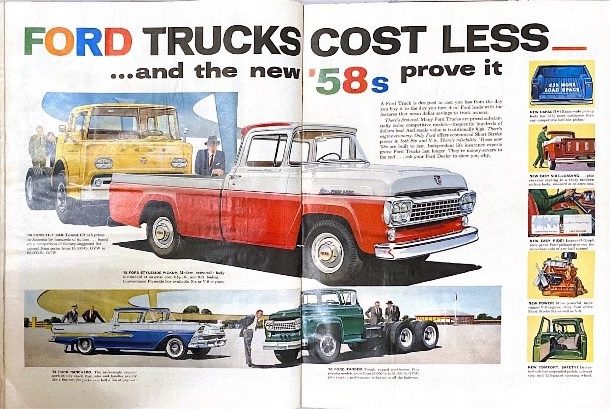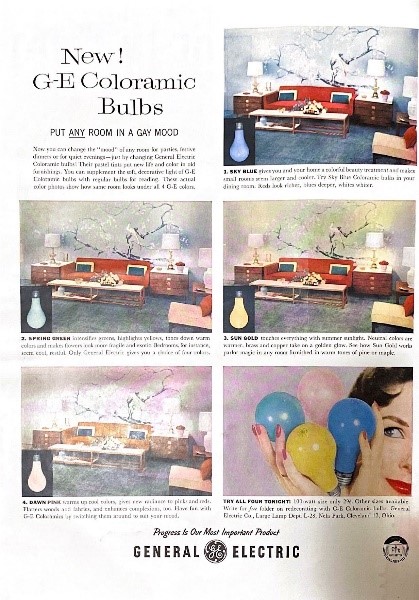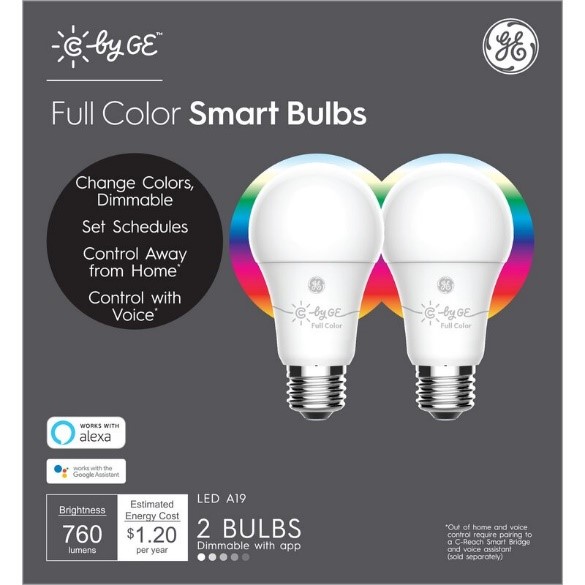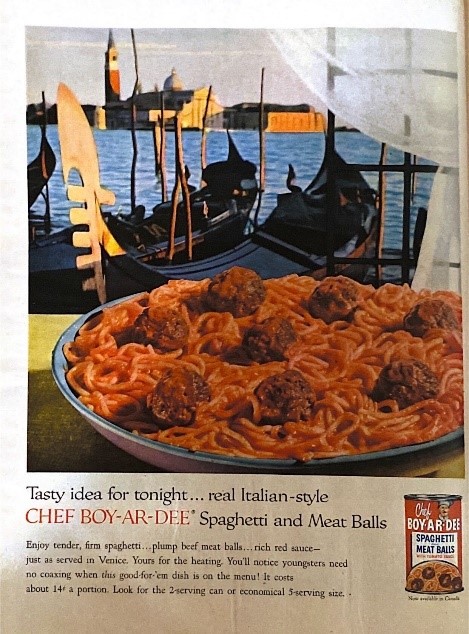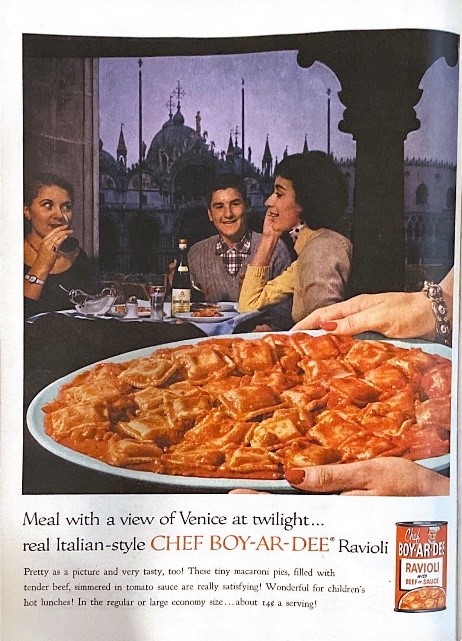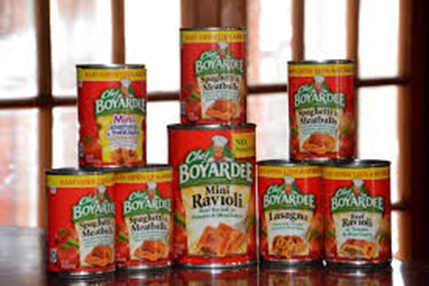The 1950’s are often considered the golden age of advertising. Families were looking to spend dollars post-war and companies were more than happy to help show them what they should be buying! Intern Anna recently came across some 1958 LIFE magazines and the advertisements inside got us really thinking. Exactly how has marketing changed over the past 60+ years?? From luxurious canned ravioli, to “mood lighting”, marketing has evolved dramatically over the last few decades. (Thank goodness!) Check out these flashback ads from three popular brands and some of the marketing knacks we’re still using from the “advertiser’s dream decade”.
FORD: It’s all about the words
You probably don’t need us to tell you which ad is from which decade! The 1950’s ad is loaded with content, uses a vibrant color palette, and features several images to showcase Ford’s new ’58 trucks. Each vehicle pictured in the ad has its own blurb detailing new features, and the overall visual aesthetic is reminiscent of a newspaper comic. The BOLD headline at the top catches a reader’s attention and tells them why they should buy Ford instead of the competitor – because they cost less! Take a look at other Ford ads during the 50’s and you’ll see this same line used. Hello, unique selling proposition (USP)!
Fun fact, the term USP originated in the late 1940’s by successful ad executive, Rosser Reeves, and began to gain popularity in the 1950’s. Reeves officially coined the term in his book, Reality in Advertising, first published in 1961. Reeves would be proud to know that marketers are still relying on USPs in 2020!
The present-day Ford ad swaps the focus, relying heavily on visual aspects and minimal verbiage. While the ad is simple with only two lines of text, both pack a punch. “THE FUTURE IS BUILT” assures consumers that Ford knows the formula to successfully building vehicles and creating leading technology. It’s through action and hard work that the future will be built. The point is driven (hehe!) home again with “BUILT FORD PROUD”. With that line, Ford gives a salute to its 115-year history of producing reliable vehicles and reinforces the message that consumers can trust Ford (and be proud owners of Ford trucks).
Our takeaway: We’ll let the 1950’s keep the lengthy ad text. But like Ford, we believe in conveying a message in a simple, digestible way. One or two lines of text can be BOLD, powerful, and memorable in the mind of your customer.
GE: It’s all about the target market
It was during this decade that marketers began to conduct market research and experiment with different target markets – specifically women in traditional roles as housewives and mothers. The 1950’s ad for G-E Coloramic Bulbs is a good example. Each color bulb in the collection includes a lengthy paragraph below the image that explains how female consumers could style the product for parties, festive dinners, or quiet evenings at home. GE goes into great detail to explain to their audience – the ‘50s housewife – exactly how she can use this product to accentuate mood and aesthetic. The Sky Blue gives, “you and your room a colorful beauty treatment!” During the post-war era, men were back home resuming the positions they previously held in their careers while women were placed in the role of a hardworking homemaker – with the most flattering lighting of course!
Today, we’d take a bit of a different approach. And thankfully GE did too. The recent Full Color Smart Bulbs ad only briefly describes the product’s features in the form of easy, quick and digestible bullet points. The simple gradient color behind the bulbs gives consumers all that they need to envision the bulb’s effect in their own homes. And we’re happy to report no mention of “beauty treatments” to be found. GE expanded its target market, which we could assume is any person – male or female – that owns a home and is interested in smart devices.
Our takeaway: Seventy years ago, marketers realized the value of knowing more about their audience. Identifying your target audience and understanding their need and wants remains a crucial part of selling. But equally crucial is not allowing that targeting to overstep into stereotypes. While women buy or influence 85% of all consumer products, 91% still feel advertisers don’t understand them. Strive to be that 9%.
(Source: Yankelovich Monitor and Greenfield Online)
CHEF BOYARDEE: It’s all about the experience
And last but certainly not least, we have the “lifestyle” advertisements. In 1958, these ads typically spoke to the growing middle-to-upper-middle class. Chef Boyardee sold a spontaneous Italian dinner, served with only the finest of wines as though the canned meal were today’s special on a restaurant menu, “Tiny macaroni pies, filled with tender beef, simmered in tomato sauce.” Yum! Chef Boyardee didn’t sell pasta in a can… the company sold an entire experience. Who wouldn’t want to dine on deliciously convenient Italian cuisine while sipping fine wine?
Fast forward to 2020, Chef Boyardee has switched up not only their marketing but their product development too. You won’t be finding any Chef Boyardee ads in your magazines these days. And what was once a luxurious nightly meal is now a convenient after-school snack complete with kid-friendly “mini” shapes and “ABC” pasta. As society’s palette evolved and our knowledge of health and wellness expanded, Chef Boyardee successfully pivoted to appeal to the new realities of working moms and kids home alone after school. Canned dinners are largely a thing of the past, but easy afternoon snacks for kids are all the rage.
Our takeaway: Offering your target audience a particular experience can be incredibly impactful – as long as it’s desirable! Keep your finger on the pulse with what’s current and what your audience needs and wants. Be ready to pivot slowly over time or at a moment’s notice, especially in this fast-paced world (looking at you, 2020!).
It’s hard to imagine what the marketers 60+ years from now will say about our creative work. Perhaps they will laugh that we still entertained print media or scoff at our big BOLD statements. Only time will tell, but for now, we will continue to stay curious and inspired!

